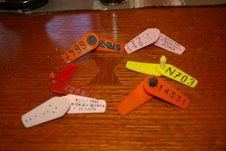Tags for Living Creatures…GPS for Humans
 Story/Photo by John Vonderlin
Story/Photo by John VonderlinEmail John ([email protected])
Hi June,
I’ve attached a photo of a collection of plastic tags, mainly coughed up by Neptune’s Vomitorium. The most recent addition is the yellow one with #N703 on it. I found that one on Bradley Beach, south of Ano Nuevo, during my search for the access to the historic Waddell Bluff Bypass beach road a couple of weeks ago. Once again thanks to the Internet I was able to trace it. In this case back to the Dalton Marketing Group, a company that makes a wide variety of tags suitable for all sorts of domesticated and wild animals. This particular tag is identified as a coffin-shaped Superflexitag. Below is the company’s explanation of the product.
Wider Gap for Thicker Fins
Regular tags are designed for ears but there are many circumstances where the gap between the two parts is not wide enough for fins which grow thicker as the creature ages.
Especially designed for Marine applications such as Turtles, Elephant Seals, Walrus and Certain Sharks. The Superflexitag uses a sold nylon pin with no needle in the applicator. Being Nylon with no hollow shaft the durability of this tag is unequalled. Available hot foil double deep embossed or laser printed as required.
Regular tags are designed for ears but there are many circumstances where the gap between the two parts is not wide enough for fins which grow thicker as the creature ages.
Especially designed for Marine applications such as Turtles, Elephant Seals, Walrus and Certain Sharks. The Superflexitag uses a sold nylon pin with no needle in the applicator. Being Nylon with no hollow shaft the durability of this tag is unequalled. Available hot foil double deep embossed or laser printed as required.
Based on this info and its location, it’s probably safe to hypothesize it was once on an Elephant Seal. However, while researching the matter I discovered the website below that encourages researchers worldwide to submit the relevant information about tagging for their Sea Turtle research. Out of the hundreds listed, none fit the tag’s number and description. But, being voluntary it may not be a comprehensive list.
… for Sea Turtle Research (ACCSTR) is maintaining the Sea Turtle Tag Inventory. … tag series issued by the Cooperative Marine Turtle Tagging Program (CMTTP) …
accstr.ufl.edu/taginv.html
You’d think researchers would be interested in knowing where the tags are eventually found after the death and disintegration of the tagged animal, but that doesn’t seem to be the case. Only the pink ones have a contact request on them, PRBO in those cases. PRBO stands for the Point Reyes Bird Observatory, which is a large conservation and research organization. Unfortunately, when contacted they seemed to lack the “organized,” part as they seemed unaware of whom to contact and never got back to us.
The orange one has N.O.A.A. N.M.F.S. and a Long Beach address on it. That’s the National Marine Fisheries Service of the National Oceanic and Atmospheric Administration. Since they didn’t ask us to contact them on the tag we didn’t bother.
We’ve seen a few other color tags, but didn’t collect them, as they were still pinned to dead pinniped’s flippers. After all I might collect marine debris, but I’m not a ghoul. In that case Meg calls the famous bone collector Ray Bandar and he drives down from San Francisco and cuts their head off to add to his world’s largest research collection of marine mammal skulls. Kind of makes me feel normal knowing folks like Ray are out there. Besides, though some of the stuff I drag home reeks of decay, thanks to hitchhiking flora and fauna, I don’t have to keep a seperate car just for specimen recovery like Ray does. Enjoy. John

